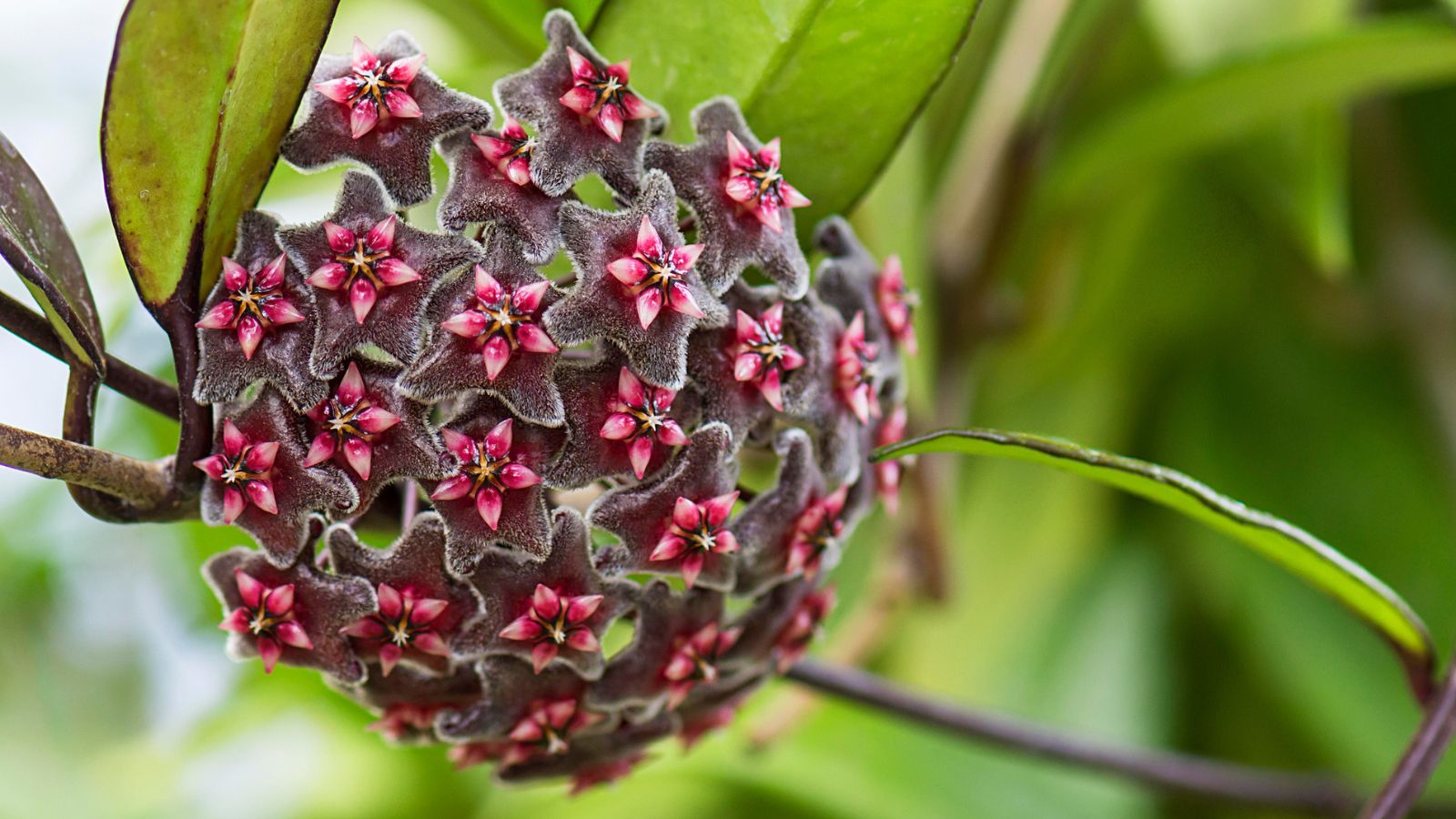Hoya plant care – and how to grow this pretty house plant
Discover how to keep your hoyas in top condition year-round with our experts’ guide to their care


With twining stems of colorful leaves and sparkling domed flowerheads that emit a sweet fragrance, hoyas, or wax flowers as they’re also known, are a must for any plant parent who can offer them the right conditions.
One of the best indoor flowering plants, hoyas are natives of South-East Asia and Australia, most are epiphytes, which means they grow on the branches and trunks of trees where they bask in the dappled light beneath the canopies.
Among the most popular species is the easy-going Hoya carnosa and its cultivars. Paris Lalicata, Plant Education + Community Engagement Associate for the online retailer The Sill recommends H. carnosa ‘Tricolor’, a vine with trailing stems of colorful leaves adorned with pink, cream and green variegation, and ‘Compacta’, or the Hindu rope plant, which produces long stems of thick, twisted, waxy leaves that hang down like ropes.
Joe Ferrari, owner of Brooklyn-based plant store and online retailer Tend Greenpoint is another fan of hoyas. One his of favorites is Hoya pubicalyx: 'I love its elongated dark green leaves speckled with white flecks, giving it the common name "Silver splash". Another favorite is Hoya obovata, with its climbing or trailing stems of wide, round, paddle-like leaves.'
However, the hoya most people will be familiar with is the lucky heart, Hoya kerrii, which is usually sold as small leaf cuttings on Valentine’s Day, due to its unusual heart shape. While this may look like a little succulent, it too is a vine and if you buy one with two leaves, it may eventually produce long twining stems of decorative foliage.
How to care for hoyas

About 30 different varieties of hoya are available to buy as houseplants, offering a wide choice of shapes, colors and textures, ranging from wide patterned foliage to narrow grass-like leaves.
'In the right conditions, hoyas will also reward you with little bouquets of highly fragrant, pink or white waxy flowers, too,' says Joe.
Design expertise in your inbox – from inspiring decorating ideas and beautiful celebrity homes to practical gardening advice and shopping round-ups.
The intricate, slightly furry flowers are held in domed clusters and make a great talking point when they appear in the summer. Remember to also leave the flower stalk (peduncle) intact after flowering as more blooms often appear on these old stumps.
'They don't require much attention other than a light watering schedule and some fertilizing here and there,' explains Joe. 'And while some hang straight down as they grow, the tendrils of others will twine around anything they can find,' continues Joe.
Where to grow hoyas?
Both Joe and Paris recommend east- or west-facing windows for hoyas, but also remember to factor in their trailing or climbing stems when positioning them.
'They are perfect for a hanging basket or shelf where these vines can cascade over the sides,' says Paris. Alternatively, add trellis or a wire hoop to the pot, or wire up a wall for their stems to climb up.
Like many tropical plants, hoyas like atmospheric humidity and will thrive in a kitchen or bathroom, given the right light conditions, although those with thicker, fleshy leaves can tolerate lower levels of humidity and would be happy in other rooms.
Sticky nectar can also drip from the lush flowers when they are in bloom, so do not place them above a carpet or other surface that cannot be cleaned easily.
How to water and feed hoyas
'Because these plants are epiphytic and grow on trees, they generally don't need a ton of water in their soil,' says Joe.
Leave your plant to dry out between waterings but do not let it become too parched, which may result in leaf loss or yellowing. Make sure your hoya is in a pot with drainage holes in the base and, ideally, water it over a sink, giving it a long drink before leaving the pot to drain, then replace your plant in its basket or waterproof container. This will help to ensure it receives sufficient moisture without the potting soil becoming waterlogged. Reduce watering in winter when plants are dormant.
Joe adds: 'While they like a humid environment, hoyas don't necessarily need to be misted frequently. Instead, keep them away from radiators or the direct path of air conditioning.'
Paris says that because hoyas are slow growers, they don’t need too much fertilizer either. 'When potting a hoya, it will initially get the essential nutrients it needs from the soil, which could last from six to 12 months, depending on the product you use and the conditions the plant is exposed to,' she says.
Only feed your plants once a month during the spring and summer when they are in full growth, following the application rates recommended on the packaging.
Joe uses an organic houseplant fertilizer (we like Organic Indoor Plant Food, at Amazon) or a sprayable orchid feed (Organic Orchid Food, at Amazon, is also highly rated), which he says helps to mimic the plants’ natural habit of capturing the nutrients from above.
Problems when growing hoyas
Overwatering
The overzealous house plant parent may find their hoyas drop their leaves and stems die back due to overwatering. Soggy soil can quickly cause root rot, which can be prevented by following the watering advice above carefully.
Room temperature and light levels
Also make sure your room is warm enough for these tropical beauties, and that they receive sufficient light since low levels of sunlight can prevent plants from flowering.
Pests
While hoyas are not particularly prone to pests, they may come under attack from mealybug, scale insect or whitefly. All three suck the sap from their hosts and will cause distorted growth. Mealybugs resemble little woodlice and hide under a fluffy white coating, while scale insects have a shell-like appearance. Whitefly are, as you may imagine, tiny white flies which also excrete a sugary honeydew on which sooty moulds grow.
You can usually wipe off mealybug and scale eggs and whitefly nymphs (larvae) with a cloth and water. If they persist but are only attached to a few leaves, simply remove the affected parts. For heavier infestations of mealybug and scale insect, try an insecticidal soap or organic sprays based on natural pyrethrum or plant oils. The best control for whitefly is an application of parasitoid wasps, Encarsia formosa, which prey on the nymphs. You can buy these wasps from biological control suppliers – to apply them, simply follow the instructions on the packaging.
FAQs
Can hoyas be grown outside?
'Hoyas prefer temperatures of between 68 and 75°F so they can go outside during the summer months in areas with cold winters and the warm, humid conditions can also speed up their growth and even induce them to bloom,' explains Paris.
However, she warns that your plants must be in pots with drainage holes in the base to prevent waterlogging. 'Also keep them in full shade, since direct sunlight outdoors can scorch the leaves – sunburn usually looks like white patches on the leaves. Depending on temperatures and humidity levels outdoors, you may need to water your plant more frequently compared to when it was indoors, so check in on your hoya at least every two to three days to see if the soil has dried out. And once temperatures start to drop below 60°F day or night, bring your plant back indoors,' she adds.
Do hoyas like sun or shade?
Joe Ferrari recommends taking your cue from hoya’s natural habitats and emulating the dappled shade they enjoy in the wild. 'When grown as houseplants hoyas generally like several hours of bright, indirect light. We've found that east- or west-facing windows with some dappled light are good,' he says. 'In city apartments, a window with a tree out front is great, which will shade them slightly from strong sunlight.'
Paris Lalicata adds that too much sun, especially from a south-facing window will scorch or discolor their leaves. 'If you only have south windows, set your hoyas back a few feet so they aren’t exposed to the direct sunbeams in the afternoon, or draw a sheer curtain to diffuse the light. North-facing windows that only provide low levels of indirect light are not really ideal for hoyas and will stunt their growth.'
Indoors, you can use the trailing stems of a Hoya carnosa to decorate a hanging basket in a bright room with some shade during the day. Note that hoyas’ beautiful, slightly furry flowers may fail to appear if the plant is in a gloomy spot with insufficient sunlight. Outdoors, the trailing stems of round flecked leaves of Hoya obovata make a pretty edging plant for a garden container in summer. The nectar-rich flowers will draw butterflies in the summer months.

Zia Allaway is a garden book author, editor, and journalist, and writes for a range of gardening and women’s magazines, including Easy Gardens, Homes & Gardens and Livingetc, as well as The Guardian and The Daily Telegraph newspapers. She has also written books for the Royal Horticultural Society and Dorling Kindersley publishers, including Eco-Gardening, Compost, Low Maintenance, Practical House Plant Book, Practical Cactus & Succulent Book, Indoor Edible Garden, What Plant Where, and the Encyclopedia of Plants and Flowers.